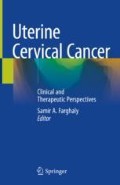Abstract
Cervical cancer is the fourth most common cancer affecting women worldwide and the second commonest cancer affecting women in developing countries. In 2012 there were 530,000 new diagnoses (7.5% of all new cancer diagnoses in women) with 84% of these in resource-poor countries. In the same year, 270,000 women lost their lives to what is a preventable and treatable disease, and the overwhelming majority of these deaths were in women living in low- or middle-income countries.
Most cases of cervical cancer are attributable to infection with the human papillomavirus (HPV), with types 16 and 18 causing up to 70% of all cervical cancers and precancerous lesions. HPV is transmitted sexually. It is usually acquired soon after the onset of sexual activity and is therefore extremely common in men and women who are sexually active.
The World Health Organization strategy for the prevention of cervical cancer comprises primary, secondary, and tertiary prevention for women at different stages of their lives and in various stages of the natural history of the disease.
Access this chapter
Tax calculation will be finalised at checkout
Purchases are for personal use only
References
Bray F, et al. Global estimates of cancer prevalence for 27 sites in the adult population in 2008. Int J Cancer. 2013;132(5):1133–45.
Ferlay J, et al. GLOBOCAN 2012 v1.0, Cancer incidence and mortality worldwide: IARC CancerBase No. 11 [Internet]. Lyon, France: International Agency for Research on Cancer; 2013. Available from: http://globocan.iarc.fr
Human papilloma virus (HPV) and cervical cancer WHO Fact Sheet, Updated June 2016 http://www.who.int/mediacentre/factsheets/fs380/en/
Goodman A. HPV testing as a screen for cervical cancer. BMJ. 2015;350:h2372.
Kahn J. HPV vaccination for the prevention of cervical intraepithelial neoplasia. N Engl J Med. 2009;361(3):271–8.
Quah YL, Aggarwal IM. 10 minute consultation. Discussing human papilloma virus vaccination. BMJ. 2017;357:j2730.
Crosbie EJ, Brabin L. Cervical cancer: problem solved? Vaccinating girls against human papillomavirus. BJOG. 2010;117(2):137–42.
Garland SM, et al. Females United to Unilaterally Reduce Endo/Ectocervical Disease (FUTURE) Investigators. Quadrivalent vaccine against human papilloma virus to prevent anogenital diseases. N Engl J Med. 2007;357:1928–43.
FUTURE II Study Group. Quadrivalent vaccine against human papilloma virus to prevent high-grade cervical lesions. N Engl J Med. 2007;357:1915–27.
Centers for Disease Control and Prevention. Human papilloma virus (HPV) vaccine safety. CDC, 2015. www.cdc.gov/vaccinesafety/vaccines/hpv-vaccine.html
Joura EA, et al. A 9-valent vaccine against infection and intraepithelial neoplasia in women. N Engl J Med. 2015;372(8):711–23.
De Vincenzo R, et al. Long term efficacy and safety of human papilloma virus vaccination. Int J Womens Health. 2014;357:999–1010.
Narducci A, Einarson A, Bozzo P. Human papilloma virus vaccine and pregnancy. Can Fam Physician. 2012;58(3):268–9.
Ma B, Roden R, Wu TC. Current status of HPV vaccines. J Formos Med Assoc. 2010;109(7):481–3.
Agosti JM, Goldie SJ. Introducing HPV vaccine in developing countries – key challenges and issues. N Engl J Med. 2007;356(19):1908–10.
Trimble CL, Frazer IH. Development of therapeutic HPV vaccines. Lancet Oncol. 2009;10(10):975–80.
Yang A, et al. Perspectives for therapeutic HPV vaccine development. J Biomed Sci. 2016;23(1):75.
Vilos GA. The history of the Papanicolaou smear and the odyssey of George and Andromache Papanicolaou. Obstet Gynecol. 1998;91(3):479–83.
Sasieni P, Castanon A, Cuzick J. Effectiveness of cervical screening with age: population based case-control study of prospectively recorded data. BMJ. 2009;339:b2968. https://doi.org/10.1136/bmj.B2968.
Martin-Hirsch P. Commentary on ‘Use of a high-risk human papilloma virus DNA test as the primary test in a cervical cancer screening programme: a population-based cohort study’. BJOG. 2013;120(10):1267–8.
Gakidou E, Nordhagen S, Obermeyer Z. Coverage of cervical screening in 57 countries: low average levels and large inequalities. PLoS Med. 2008;5(6):e132. https://doi.org/10.1371/journal.pmed.0050132.
World Health Organisation International Agency for Research on Cancer Screening Group. Visual Inspection with Acetic Acid: Evidence to Date. 2002. http://screening.iarc.fr/doc/RH_via_evidence.pdf. Accessed 11 June 2017.
Ketelaars PJW, et al. High risk human papilloma virus detection in self-sampling compared to physician taken smear in a responder population of the Dutch cervical screening: Results of the VERA study. Prev Med. 2017;101:96–101.
Mayrand MH, et al. Human papilloma virus DNA versus Papanicolaou screening tests for cervical cancer. N Engl J Med. 2007;357(16):1579–88.
Lazcano Ponce E, et al. Self-collection of vaginal specimens for human papilloma virus testing in cervical cancer prevention (MARCH): a community-based randomized controlled trial. Lancet. 2011;378(9806):1868–73.
World Health Organisation, Department of Reproductive Health and Research and Department of Chronic Diseases and Health Promotion, Geneva. Comprehensive cervical cancer control: a guide to essential practice (C4-GEP) 2006. http://www.who.int/reproductivehealth/publications/cancers/9241547006/en. Accessed 11 June 2017.
World Health Organisation. WHO Guidelines for Screening and Treatment of Precancerous Lesions for Cervical Cancer Prevention. © World Health Organization 2013 ISBN 978 9241548694.
Rossi G, et al. Cervical cancer screening in women vaccinated against human papilloma virus infection: recommendations from a consensus conference. Prev Med. 2017;98:21–30.
Cervical Cancer Incidence and Screening Coverage, NCRAS. http://www.ncin.org.uk/publications/data_briefings/cervical_incidence_and_screening
Cervical Cancer Mortality Statistics, Cancer Research UK. http://www.cancerresearchuk.org/health-professional/cancer-statistics/statistics-by-cancer-type/cervical-cancer/mortality
World Health Organization: Global Atlas of Palliative Care at the End of Life, 2014. www.who.int/nmh/GlobalAtlasofPalliativeCare
Lim AW, et al. Cytology in the diagnosis of cervical cancer in symptomatic young women: a retrospective review. Br J Gen Pract. 2016;66(653):e871–9. Epub 2016 Oct 24
Pecorelli S. Revised FIGO staging for carcinoma of the vulva, cervix and endometrium. Int J Gynaecol Obstet. 2009;105(2):103–4.
Author information
Authors and Affiliations
Corresponding author
Editor information
Editors and Affiliations
Rights and permissions
Copyright information
© 2019 Springer Nature Switzerland AG
About this chapter
Cite this chapter
Doufekas, K., Achampong, Y., Olaitan, A. (2019). Prevention of Cervical Cancer. In: Farghaly, S. (eds) Uterine Cervical Cancer. Springer, Cham. https://doi.org/10.1007/978-3-030-02701-8_2
Download citation
DOI: https://doi.org/10.1007/978-3-030-02701-8_2
Published:
Publisher Name: Springer, Cham
Print ISBN: 978-3-030-02700-1
Online ISBN: 978-3-030-02701-8
eBook Packages: MedicineMedicine (R0)

